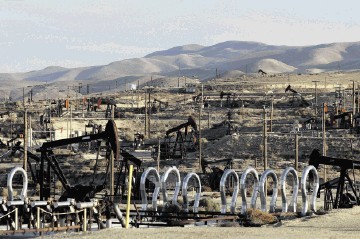
US oil output will peak at a 43-year high in 2015 as producers work through a backlog of uncompleted wells before trailing off in the second half of the year.
Production will increase to 9.43 million barrels a day this year, the most since 1972, the Energy Information Administration said Tuesday in its monthly Short-Term Energy Outlook.
That’s 240,000 barrels higher than last month’s estimate. Monthly output will fall in June through early 2016.
The US is producing more oil this year even as the number of oil rigs slid to the least since August 2010 in response to last year’s price crash.
Prices are still high enough to support drilling in key shale formations in North Dakota, Texas and other states.
“Production has increased as producers work through the backlog of uncompleted wells,” the EIA said in the report.
“Projected 2015 oil prices remain high enough to support continued development drilling in the core areas of the Bakken, Eagle Ford, Niobrara, and Permian basins.”
The increase in this year’s production forecast reflects revisions to estimated output in the first quarter, the EIA said. Oil production in May reached 9.59 million barrels a day, also the highest level since 1972.
“US oil production since mid-2014 has been more resilient to lower crude prices than many had expected,” EIA Administrator Adam Sieminski said in an e-mailed statement.
West Texas Intermediate crude, the US benchmark, slid 46 percent last year. Prices have rebounded about 40 percent from a six-year low in March.
The benchmark US grade will average $55.35 a barrel this year versus the May projection of $54.32, the EIA said.
Prices will average $62.04 next year. WTI for July delivery climbed $1.91, or 3.3 percent, to $60.05 a barrel at 1:06 p.m. on the New York Mercantile Exchange.
The EIA lowered its 2015 Brent crude estimate to $60.53 from $60.79. The European benchmark will average $67.04 next year, the agency said.
The US oil rig count fell to 642 last week, down from 1,609 on Oct. 10, according to Baker Hughes Inc. Horizontal drilling and hydraulic fracturing, or fracking, have unlocked supplies in shale formations in North Dakota, Texas and other states.
Oil production will start to decline in the second half of this year, “largely attributable to unattractive economic returns in some areas of both emerging and mature onshore oil production regions,” the EIA said.
Output will rebound in the second half of 2016, returning to an average of 9.6 million barrels in December.
Total output next year is forecast to reach 9.27 million barrels a day.
Crude output from the prolific tight-rock formations will shrink 1.3 percent to 5.58 million barrels a day this month, based on EIA estimates from the monthly Drilling Productivity report released on Monday.
It’ll drop further in July to 5.49 million, the lowest level since January.
The EIA said gasoline at US pumps will average $2.44 a gallon in 2015, up from last month’s estimate of $2.43.
The average retail price fell to $2.745 a gallon Monday nationwide after reaching $2.759 on June 3, the highest level since December, according to Heathrow, Florida-based AAA, the biggest motoring group in the US.
